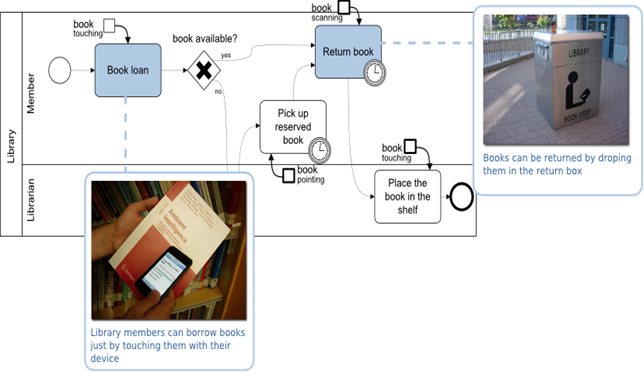Last week I had the honor to be part of the jury that evaluated the PhD Thesis of Pau Giner on
Automatic the Development of Physical Mobile Workflows” using a model-driven approach.
Roughly speaking, Physical mobile workflows are enhanced business processes that may include as workflow activities tasks resulting from the interaction of mobile devices with the physical environment. In this sense, a physical mobile workflow can be viewed as the intersection between business processes, mobile devices and the internet of things (that augment real-world elements with a digital identity). Needless to say that this kind of workflow are becoming more and more important every day and that we need new methods and techniques, as the ones proposed by Pau, to deal with their specification, implementation and evolution.

Desktop computers are not much aware of the user context. This is changing with the increasingly powerful mobile devices. Products such as
Google Goggles, Shop Savvy or Layar automate the physical virtual linkage and allow the user to get information about a physical element by making a picture of a book cover, pointing at a location or reading a barcode.
The availability of different technologies for connecting the physical and the digital world has several implications at modeling level: tasks bridging the physical and digital world have to be identified and information regarding how this interaction occurs (e.g. how the physical elements are identified, how the communication with the user takes place,…) must be made precise as part of the workflow definition. For example, we could define a workflow where users with an appropriate mobile device can automatically borrow books without interacting with the librarian.

The PhD thesis of Pau provides modeling primitives to describe how this physical-virtual linkage is performed in the workflow and how, afterwards, this physical mobile workflow can be translated into executable code for a given mobile platform. More specifically, tool support based on the Eclipse modeling project is provided to edit, validate and guide the generation of a software solution for the Android platform.

For more detail on the work, you can
read the
article published at IEEE Pervasive Computing or watch the presentation
below:
FNR Pearl Chair. Head of the Software Engineering RDI Unit at LIST. Affiliate Professor at University of Luxembourg. More about me.



Recent Comments